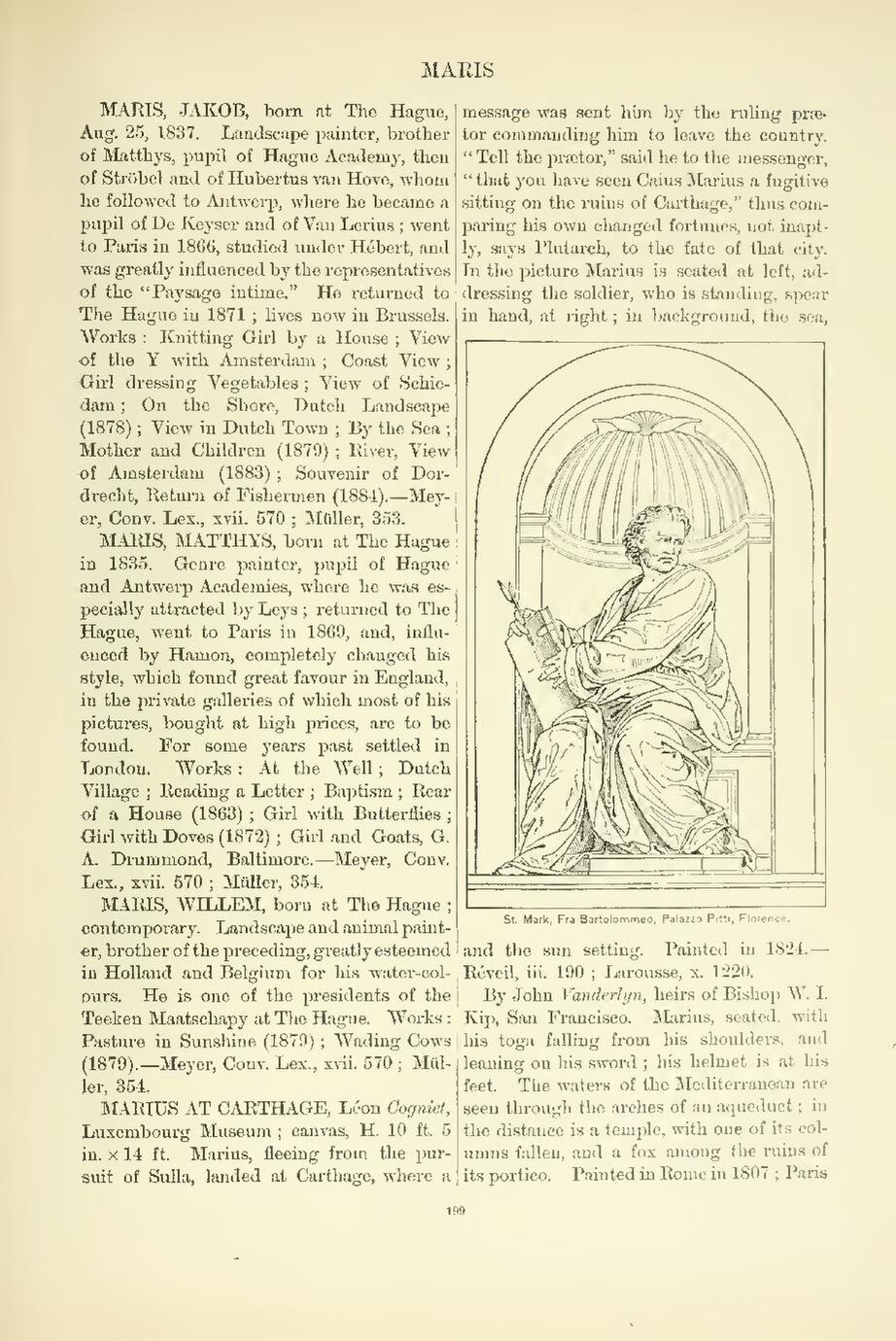MARIS, JAKOB, born at The Hague, Aug. 25, 1837. Landscape painter, brother of Matthys, pupil of Hague Academy, then of Ströbel and of Hubertus van Hove, whom he followed to Antwerp, where he became a pupil of De Keyser and of Van Lerius; went to Paris in 1866, studied under Hébert, and was greatly influenced by the representatives of the "Paysage intime." He returned to The Hague in 1871; lives now in Brussels. Works: Knitting Girl by a House; View of the Y with Amsterdam; Coast View; Girl dressing Vegetables; View of Schiedam; On the Shore, Dutch Landscape (1878); View in Dutch Town; By the Sea; Mother and Children (1879); River, View of Amsterdam (1883); Souvenir of Dordrecht, Return of Fishermen (1884).—Meyer, Conv. Lex., xvii. 570; Müller, 353.
MARIS, MATTHYS, born at The Hague
in 1835. Genre painter, pupil of Hague
and Antwerp Academies, where he was especially
attracted by Leys; returned to The
Hague, went to Paris in 1869, and, influenced
by Hamon, completely changed his
style, which found great favour in England,
in the private galleries of which most of his
pictures, bought at high prices, are to be
found. For some years past settled in
London. Works: At the Well; Dutch
Village; Reading a Letter; Baptism; Rear
of a House (1863); Girl with Butterflies;
Girl with Doves (1872); Girl and Goats, G.
A. Drummond, Baltimore.—Meyer, Conv.
Lex., xvii. 570; Müller, 354.
MARIS, WILLEM, born at The Hague;
contemporary. Landscape and animal painter,
brother of the preceding, greatly esteemed
in Holland and Belgium for his water-colours.
He is one of the presidents of the
Teeken Maatschapy at The Hague. Works:
Pasture in Sunshine (1879); Wading Cows
(1879).—Meyer, Conv. Lex., xvii. 570; Müller,
354.
An image should appear at this position in the text. To use the entire page scan as a placeholder, edit this page and replace "{{missing image}}" with "{{raw image|Cyclopedia of painters and paintings (IA cyclopediaofpain03cham).pdf/221}}". Otherwise, if you are able to provide the image then please do so. For guidance, see Wikisource:Image guidelines and Help:Adding images. |
St Mark, Fra Bartolommeo, Palazzo Pitti, Florence.
MARIUS AT CARTHAGE, Léon Cogniet, Luxembourg Museum; canvas, H. 10 ft. 5 in. × 14 ft. Marius, fleeing from the pursuit of Sulla, landed at Carthage, where a message was sent him by the ruling prætor commanding him to leave the country. "Tell the prætor," said he to the messenger, "that you have seen Caius Marius a fugitive sitting on the ruins of Carthage," thus comparing his own changed fortunes, not inaptly, says Plutarch, to the fate of that city. In the picture Marius is seated at left, addressing the soldier, who is standing, spear in hand, at right; in background, the sea, and the sun setting. Painted in 1824.—Réveil, iii. 190; Larousse, x. 1220.
By John Vanderlyn, heirs of Bishop W. I. Kip, San Francisco. Marius, seated, with his toga falling from his shoulders, and leaning on his sword; his helmet is at his feet. The waters of the Mediterranean are seen through the arches of an aqueduct; in the distance is a temple, with one of its columns fallen, and a fox among the ruins of its portico. Painted in Rome in 1807; Paris
